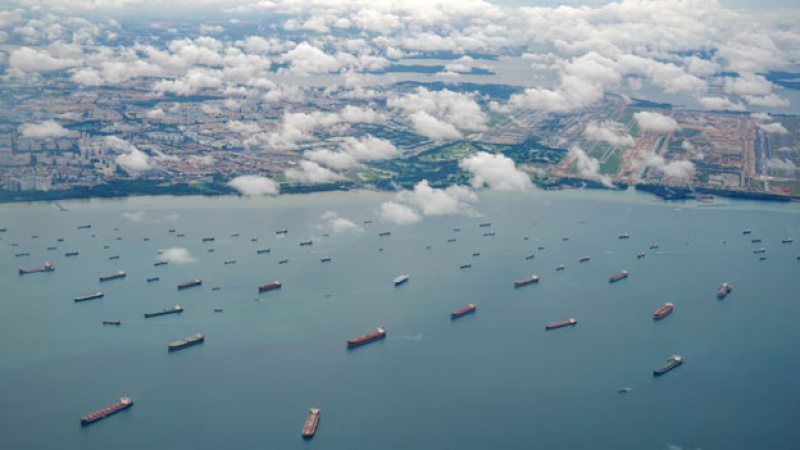- Trump considering military options on Greenland; Europe rejects |
- Fertiliser crunch threatens Kushtia’s onion boom despite high prices |
- Security Council Divided on United States' Venezuela Action |
- Over 1.53m voters register for postal balloting: Shafiqul Alam |
Clean Energy Demand Shifts Commodity Trade Toward Mining

Oil tankers entering and departing a busy port.
Two-thirds of the developing world — 95 out of 143 economies — depend on commodities for export value, accounting for 60 percent of their merchandise exports. For the least developed countries, this figure rises to 80 percent, leaving entire nations' revenues vulnerable to price swings, fiscal shocks, and evolving trade dynamics. Behind the numbers lies a deeper transformation: a disruption in fossil fuel trade and a growing reliance on mineral exports — particularly those essential to green technologies.
In 2024, during a special climate panel on critical energy transition minerals, UN Secretary-General António Guterres remarked, “A world powered by renewables is a world hungry for critical minerals. For developing countries, critical minerals are a critical opportunity — to create jobs, diversify economies, and dramatically boost revenues. But only if they are managed properly.”
Guterres sent a clear message: this change can indeed boost economies and create jobs, especially where they’re needed most, but only if those countries are willing to invest in diversification strategies and proper economic management.
At this year’s UN High-Level Political Forum, Guterres reaffirmed his stance on July 22, stating: “Fossil fuels are outdated. The sun is rising on a new era — the era of clean energy.” He presented a six-point action plan to phase out fossil fuels and secure universal energy access, outlining financing strategies for the green transition.
Between 2012–2014 and 2021–2023, the share of commodity exports in global trade slightly declined — from 35.5 percent to 32.7 percent. Meanwhile, overall merchandise trade grew by 25.6 percent, while commodity exports increased by only 15.5 percent. This 10 percent gap translates into a $619 billion shortfall, largely due to declining and stagnating energy exports, which continue to dominate commodity trade.
Once the leader of commodity trade, energy exports are now showing signs of stagnation. From 2021 to 2023, global energy exports averaged $3.16 trillion, down 1.3 percent from 2012–2014. The acceleration of renewable energy projects and the UN’s 2030 Agenda are major drivers, decreasing reliance on oil and coal while improving energy efficiency through green technology investment.
Western Asia — historically dominant in energy exports, especially oil — saw its share fall from 31.3 percent to 24.7 percent over the past decade. Russia, once the world’s top energy exporter, experienced a 26.6 percent drop in export value.
However, during the same period, the United States became the world’s leading energy exporter, thanks to massive production of liquefied natural gas (LNG) and shale oil. This shift also reflects a partial transition to greener energy, as LNG is increasingly seen as a bridge fuel with significantly lower emissions than oil and coal.
While energy exports decline, mining exports are surging. In Asia and Oceania, the region’s share of mining exports grew from 33.8 percent to 37.6 percent. In Australia alone, mining export value rose from USD 105.7 billion to USD 171 billion, driven by higher global demand for metals such as copper, cobalt, and lithium — essential for solar panels, wind turbines, and electric vehicle batteries.
While much of the world looks to a green future, Africa remains behind in development, lacking even basic electricity access in many regions. Africa is home to 20 of the world’s 33 mining export-dependent economies — supplying materials for green technologies but not producing the end products.
In Western and Eastern Africa, mining exports account for 65 and 57 percent of merchandise exports, respectively. In Southern Africa, countries like Botswana are even more reliant, with mining exports making up 91.5 percent. This lack of diversification makes African economies highly vulnerable to supply chain shocks and commodity price volatility. Even in less mining-dependent countries like Nigeria, Algeria, and Angola, a 20 percent drop in oil prices — with 80 percent of their export value tied to energy — highlights the risks of fiscal overdependence.
UNCTAD Secretary-General Rebecca Grynspan said: “There is now an opportunity to leverage these new commodities to update our trade regime, promote structural diversification, and turn the tide of commodity dependence once and for all.”
The clean energy shift is no longer theoretical — it is reshaping global supply chains in real time. Countries like the U.S. and Australia have adapted, embracing a green economy model. The rise in mining exports supports growing demand for critical minerals from advanced economies. But this financial flow may not last forever. As new competitors emerge, prices may fall — much like the trajectory of oil.
A country’s path to clean energy is now a key indicator of economic sustainability — and of breaking free from outdated financial models.

